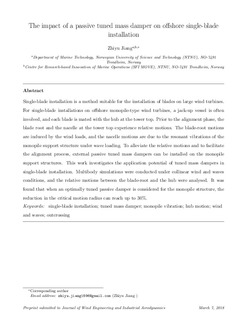| dc.contributor.author | Jiang, Zhiyu | |
| dc.date.accessioned | 2019-02-18T12:58:58Z | |
| dc.date.available | 2019-02-18T12:58:58Z | |
| dc.date.created | 2018-10-19T15:07:20Z | |
| dc.date.issued | 2018 | |
| dc.identifier.citation | Journal of Wind Engineering and Industrial Aerodynamics. 2018, 176 65-77. | nb_NO |
| dc.identifier.issn | 0167-6105 | |
| dc.identifier.uri | http://hdl.handle.net/11250/2585967 | |
| dc.description.abstract | Single-blade installation is a method suitable for the installation of blades on large wind turbines. For single-blade installations on offshore monopile-type wind turbines, a jack-up vessel is often involved, and each blade is mated with the hub at the tower top. Prior to the alignment phase, the blade root and the nacelle at the tower top experience relative motions. The blade-root motions are induced by the wind loads, and the nacelle motions are due to the resonant vibrations of the monopile support structure under wave loading. To alleviate the relative motions and to facilitate the alignment process, external passive tuned mass dampers can be installed on the monopile support structures. This work investigates the application potential of tuned mass dampers in single-blade installation. Multibody simulations were conducted under collinear wind and waves conditions, and the relative motions between the blade-root and the hub were analysed. It was found that when an optimally tuned passive damper is considered for the monopile structure, the reduction in the critical motion radius can reach up to | nb_NO |
| dc.language.iso | eng | nb_NO |
| dc.publisher | Elsevier | nb_NO |
| dc.rights | Attribution-NonCommercial-NoDerivatives 4.0 Internasjonal | * |
| dc.rights.uri | http://creativecommons.org/licenses/by-nc-nd/4.0/deed.no | * |
| dc.title | The impact of a passive tuned mass damper on offshore single-blade installation | nb_NO |
| dc.title.alternative | The impact of a passive tuned mass damper on offshore single-blade installation | nb_NO |
| dc.type | Journal article | nb_NO |
| dc.type | Peer reviewed | nb_NO |
| dc.description.version | acceptedVersion | nb_NO |
| dc.source.pagenumber | 65-77 | nb_NO |
| dc.source.volume | 176 | nb_NO |
| dc.source.journal | Journal of Wind Engineering and Industrial Aerodynamics | nb_NO |
| dc.identifier.doi | 10.1016/j.jweia.2018.03.008 | |
| dc.identifier.cristin | 1621783 | |
| dc.relation.project | Norges teknisk-naturvitenskapelige universitet: NFR project number 237929 | nb_NO |
| dc.description.localcode | © 2018. This is the authors’ accepted and refereed manuscript to the article. Locked until 16.3.2020 due to copyright restrictions. This manuscript version is made available under the CC-BY-NC-ND 4.0 license http://creativecommons.org/licenses/by-nc-nd/4.0/ | nb_NO |
| cristin.unitcode | 194,64,20,0 | |
| cristin.unitname | Institutt for marin teknikk | |
| cristin.ispublished | true | |
| cristin.fulltext | postprint | |
| cristin.qualitycode | 1 | |

